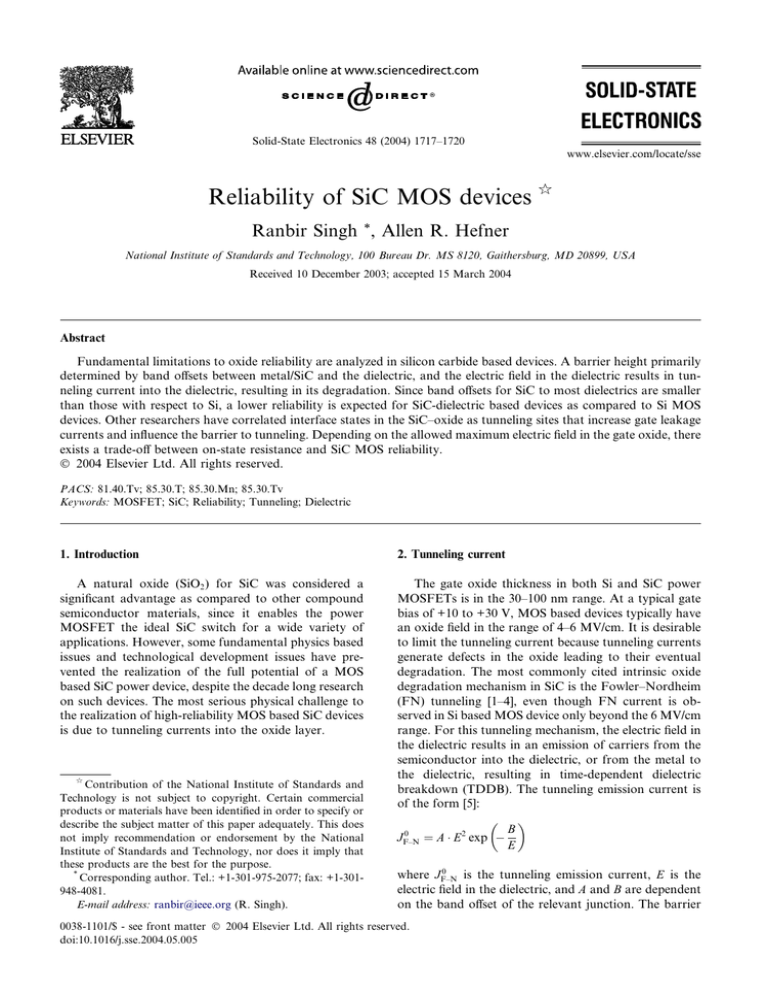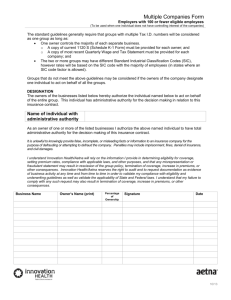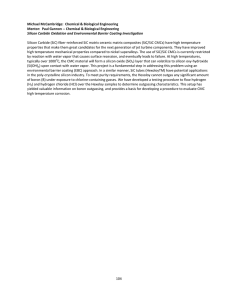
Solid-State Electronics 48 (2004) 1717–1720
www.elsevier.com/locate/sse
Reliability of SiC MOS devices q
Ranbir Singh *, Allen R. Hefner
National Institute of Standards and Technology, 100 Bureau Dr. MS 8120, Gaithersburg, MD 20899, USA
Received 10 December 2003; accepted 15 March 2004
Abstract
Fundamental limitations to oxide reliability are analyzed in silicon carbide based devices. A barrier height primarily
determined by band offsets between metal/SiC and the dielectric, and the electric field in the dielectric results in tunneling current into the dielectric, resulting in its degradation. Since band offsets for SiC to most dielectrics are smaller
than those with respect to Si, a lower reliability is expected for SiC-dielectric based devices as compared to Si MOS
devices. Other researchers have correlated interface states in the SiC–oxide as tunneling sites that increase gate leakage
currents and influence the barrier to tunneling. Depending on the allowed maximum electric field in the gate oxide, there
exists a trade-off between on-state resistance and SiC MOS reliability.
Ó 2004 Elsevier Ltd. All rights reserved.
PACS: 81.40.Tv; 85.30.T; 85.30.Mn; 85.30.Tv
Keywords: MOSFET; SiC; Reliability; Tunneling; Dielectric
1. Introduction
2. Tunneling current
A natural oxide (SiO2 ) for SiC was considered a
significant advantage as compared to other compound
semiconductor materials, since it enables the power
MOSFET the ideal SiC switch for a wide variety of
applications. However, some fundamental physics based
issues and technological development issues have prevented the realization of the full potential of a MOS
based SiC power device, despite the decade long research
on such devices. The most serious physical challenge to
the realization of high-reliability MOS based SiC devices
is due to tunneling currents into the oxide layer.
The gate oxide thickness in both Si and SiC power
MOSFETs is in the 30–100 nm range. At a typical gate
bias of +10 to +30 V, MOS based devices typically have
an oxide field in the range of 4–6 MV/cm. It is desirable
to limit the tunneling current because tunneling currents
generate defects in the oxide leading to their eventual
degradation. The most commonly cited intrinsic oxide
degradation mechanism in SiC is the Fowler–Nordheim
(FN) tunneling [1–4], even though FN current is observed in Si based MOS device only beyond the 6 MV/cm
range. For this tunneling mechanism, the electric field in
the dielectric results in an emission of carriers from the
semiconductor into the dielectric, or from the metal to
the dielectric, resulting in time-dependent dielectric
breakdown (TDDB). The tunneling emission current is
of the form [5]:
B
0
JF–N
¼ A E2 exp E
q
Contribution of the National Institute of Standards and
Technology is not subject to copyright. Certain commercial
products or materials have been identified in order to specify or
describe the subject matter of this paper adequately. This does
not imply recommendation or endorsement by the National
Institute of Standards and Technology, nor does it imply that
these products are the best for the purpose.
*
Corresponding author. Tel.: +1-301-975-2077; fax: +1-301948-4081.
E-mail address: ranbir@ieee.org (R. Singh).
0
where JF–N
is the tunneling emission current, E is the
electric field in the dielectric, and A and B are dependent
on the band offset of the relevant junction. The barrier
0038-1101/$ - see front matter Ó 2004 Elsevier Ltd. All rights reserved.
doi:10.1016/j.sse.2004.05.005
1718
R. Singh, A.R. Hefner / Solid-State Electronics 48 (2004) 1717–1720
height (UB ) is defined as the difference between the
electron affinities of the metal/semiconductor and the
dielectric. A and B have the following dependence on
barrier height:
A/
1
UB
B / ðUB Þ3=2
Note that tunneling current emission is exponentially
dependent on both the electric field in the dielectric and
the barrier height between the dielectric and the metal
or semiconductor. The temperature dependence of FN
tunneling is treated in detail by Pananakakis et al. [5].
To the first order, the FN current can be assumed to be
proportional to the square of temperature, if the temperature dependence of Fermi level (and hence the
barrier height) is ignored.
3. MOS under inversion
For this discussion, MOS under inversion is defined
to be when an NMOS device has a positive bias on the
gate with respect to the substrate, or when a PMOS
device has a negative gate bias with respect to the substrate. Here, the discussion is concentrated on the
NMOS case, while a similar parallel exists for the PMOS
case. The barrier height for the purposes of FN tunneling is calculated as the difference between the conduction band of the dielectric and the Fermi level of
the semiconductor. In the worst case scenario for an
NMOSFET, the Fermi level may assumed to lie at the
conduction band, which corresponds to a very strong
inversion case, or when highly doped N-type SiC is used.
For this condition, the barrier height for FN tunneling is
the conduction band offset between SiC and the dielectric, which is SiO2 for further discussion. FN tunneling
currents are expected to be much higher for a SiC based
MOSFET than for a Si based device for the same electric
field because the conduction band offset between SiC
and SiO2 is smaller than that between Si and SiO2 . As
shown in Fig. 1, the conduction band offset in the Si–
SiO2 interface is 3.2 eV, but it is only 2.7 eV for 4H–SiC.
For the same FN tunneling current, this 0.5 eV difference in the band offset will require that the electric field
in the dielectric for a 4H–SiC/SiO2 system be reduced by
approximately 1.5X as compared to a Si/SiO2 system. In
commercial Si NMOSFETs, the electric field in SiO2 is
kept below 4–5 MV/cm, so that a reasonable 10 yr life is
achieved [6]. Tunneling is the primary device lifetime
limiting factor for MOS based devices, and is rated only
to a maximum temperature of 125 °C. For a 3 MV/cm
maximum electric field in the dielectric of a SiC NMOS,
the maximum gate bias must be limited to only +15 V
Fig. 1. Dielectric constants, and critical electric fields of various
semiconductors (Si, 6H–SiC, 4H–SiC) and dielectrics (SiO2 ,
Si3 N4 and Al2 O3 ). Conduction and valence band offsets of these
are also shown with respect to SiO2 .
for the typical 50 nm gate dielectric thickness at room
temperature. At higher temperatures, the electric field in
the dielectric (and hence the gate bias) must be made
even smaller in order to make MOS reliability approach
that of a Si MOS transistor. Although the valence band
offset (and hence the barrier height) decreases more
dramatically than the conduction band offset (from 4.7
eV in the Si/SiO2 system to 3.05 eV in the 4H–SiC/SiO2
system), PMOSFET reliability may be higher than
NMOSFET reliability, because the band offset of 3.05
eV is still greater than the 2.7 eV for NMOS [7]. Ironically, the wider bandgap of SiC seems like a liability
rather than an asset for high temperature operation
because its band structure occupies a larger portion of
the SiO2 band structure.
From this discussion, it seems that the reliability of a
conventional SiC NMOS device is lower than that of a
Si NMOS devices under typical operating conditions,
and is unacceptably poor at higher operating temperatures. However, this conclusion is drawn from the worstcase scenario of assuming the barrier height for the
purposes of FN tunneling is equal to the conduction
band offset of 4H–SiC and SiO2 , i.e. the case of strong
inversion. A significant gain in the barrier height may be
achieved if the Fermi level in SiC is below the conduction band, i.e. an enhancement-mode MOSFETs (with
p-type SiC) under weak inversion condition [8]. The gate
bias range when the MOSFET is under a weak inversion
condition is determined by the doping of the p-type base
region. At the onset of weak inversion the barrier height
(UF ) may be as much as 4.3 eV (1.6 + 2.7 eV, UC ), as
shown in Fig. 2. A barrier height of 4.3 eV will allow a
higher temperature operation of 4H–SiC based MOSFETs as compared to Si based MOSFETs (with a
maximum barrier height of 3.75 eV), for an identical onstate electric field in the dielectric. This assumes that
channel mobilities for Si and 4H–SiC MOSFET are
similar for an identical electric field in the dielectric.
R. Singh, A.R. Hefner / Solid-State Electronics 48 (2004) 1717–1720
Fig. 2. Enhancement-mode SiC MOSFET under weak inversion case. The relevant barrier heights for FN tunneling in SiC–
SiO2 interface: UC is the conduction band offset, UF is the
theoretical FN barrier height, and Ueff is the effective barrier
height due to the presence of interface states at the SiC–SiO2
interface.
Despite more than a decade of research, relatively
modest success has been achieved in the realization of
acceptable channel mobilities [9] for enhancement-mode
NMOSFETs. Because of the low channel mobility observed in most 4H–SiC based MOS devices, a higher
gate bias (and electric field) may be required in order to
realize a low channel resistance in a SiC power MOSFET. This represents a challenge for achieving a high
reliability in SiC based MOS devices at all temperatures.
Hence, there exists an on-state performance/reliability
trade-off determined by experimentally obtained channel
mobility and the doping of the SiC used to make the
NMOSFET.
4. Impact of interface states
The on-state/reliability trade-off is severely influenced
by the experimentally obtained traps and carrier energy
states at the SiC-dielectric interface. The origin of these
traps is linked to the imperfect nature of 4H–SiC/
dielectric interfaces, like the presence of carbon clusters
[10] and/or dangling Si and C bonds. A significant
number of electrons that are expected to provide the low
on-resistance of the inversion layer get trapped in these
energy states and scatter mobile electrons, further
increasing the resistance in the channel region. Experimental data by Ouisse and Bano [11] shows that the low
channel mobility in 4H–SiC is directly linked to
extraordinarily high interface state densities in the SiO2 /
SiC interface. In the energy band diagram, the interface
traps that influence channel mobility are located between the Fermi level and the conduction band of the
1719
SiC, as shown in Fig. 2. Experimental data by Schorner
[12] has shown that the density of these interface states
exponentially increase beyond a level of 2.4 eV above the
valence band of all SiC polytypes. This is used to explain
the anomalously low electron inversion mobility in 4H–
SiC MOSFETs, as compared to those obtained in other
polytypes of SiC.
The location and density of interface states within the
bandgap influences not only channel mobility, but also
the FN tunneling currents at the SiC-dielectric interface.
It has been shown [1] that the interface states act as the
primary source of FN tunneling into the oxide, rather
than the position of the Fermi level. Rather than a well
defined barrier height determined by the difference between the Fermi level and conduction band, an ‘effective’
barrier height (Ueff ) is typically observed in most cases
which is determined by the density and location of the
interface states [1] in the energy gap. Since most of the
interface states are located close to the conduction band
edge, Ueff is close to the conduction band offset of the
SiC–SiO2 interface. High temperature FN tunneling
current data on n-type SiC by Li et al. [3] shows that the
‘effective’ barrier height decreases to only 2.38 eV as the
operating temperature is increased to 300 °C as compared to the 2.7 eV conduction band offset difference
at room temperature. Similarly, a lower FN tunneling
barrier height was experimentally observed in 4H–SiC
PMOSFETs by Chanana et al. [4], indicating the strong
influence of interface states on FN tunneling current
rather than the position of Fermi level.
It is sometimes mentioned that the low inversion
layer mobility in power NMOSFETs may be acceptable
for higher voltage (>2 kV) MOSFETs since a lower
proportion of the resistance is contributed by the
channel. However, if the MOS interface state density at
the SiC-dielectric is high, the viability of these devices
will be determined primarily by FN tunneling. The
electric field in the dielectric must be kept correspondingly lower to limit FN tunneling current. The reduction
in interface state densities in MOS structures will play a
critical role in the on-state and high temperature performance, as well as reliability of power MOSFETs in
4H–SiC.
5. Conclusions
The reliability of SiO2 in a SiC MOS based device is
determined by tunneling current. If an intrinsic Fowler–
Nordheim regime of tunneling is assumed, tunneling
current is exponentially dependent on the electric field in
the dielectric and barrier height to carriers. This barrier
height is primarily determined by band offsets between
metal/SiC and the dielectric. Since band offsets for SiC
to most dielectrics are smaller than those with respect to
Si, a lower reliability is expected for SiC-dielectric based
1720
R. Singh, A.R. Hefner / Solid-State Electronics 48 (2004) 1717–1720
devices as compared to MOS devices for the same oxide
electric field. SiC-dielectric interface states affect channel
mobilities and may determine the barrier height for
Fowler–Nordheim tunneling. There exists a trade-off
between on-state resistance and SiC-dielectric reliability,
which is influenced by the dielectric thickness in a forward biased SiC-dielectric structure. The use of alternative dielectrics to improve this trade-off will soon be
published in a detailed paper [13].
[5]
[6]
[7]
[8]
References
[1] Afanasev VV, Bassler M, Pensl G, Schulz MJ. Band offsets
and electronic structure of SiC/SiO2 interfaces. Journal of
Applied Physics 1996;79(6):3108–14.
[2] Agarwal AK, Seshadri S, Rowland LB. Temperature
dependence of Fowler–Nordheim current in 6H– and
4H–SiC MOS capacitors. IEEE Electron Device Letters
1997;18(12):592–4.
[3] Li H-f, Dimitrijev S, Sweatman D, Harrison HB. Analysis
of Fowler–Nordheim injection in NO nitrided gate oxide
grown on n-type 4H–SiC. Proc 22nd International Conference on Microelectronics (MIEL 2000), vol. 1, Nis,
Serbia, 2000. pp. 331–333.
[4] Chanana RK, McDonald K, Ventra MD, Pantelides ST,
Chung GY, Tin CC, Williams JR, Weller RA. Fowler–
[9]
[10]
[11]
[12]
[13]
Nordheim hole tunneling in p-SiC/SiO2 structures. Applied
Physics Letters 2000;77(16):2560–2.
Pananakakis G, Ghibaudo G, Kies R. Temperature
dependence of the Fowler–Nordheim current in metaloxide-degenerate structures. Journal of Applied Physics
1995;78(4):2635–41.
http://public.itrs.net/.
Singh R, Ryu Sei-Hyung, Capell DC, Palmour JW. High
temperature SiC trench gate p-IGBTs. IEEE Transactions
on Electron Devices 2003;50(3):774–84.
Sze SM. Physics of semiconductor devices. New York:
John Wiley & Sons; 1981.
Chung GY, Tin CC, Williams JR, McDonald K, Di Ventra
M, Pantelides ST, et al. Effect of nitric oxide annealing on
the interface trap densities near the band edges in the 4H
polytype of silicon carbide. Applied Physics Letters
2000;76(13):1713–5.
Afanasev VV, Bassler M, Pensl G, Schultz M. Intrinsic
SiC/SiO2 interface states. Physica Status Solidi (a)
1997;162:321.
Ouisse T, Bano E. Electronic properties of the SiC–SiO2
interface and related systems. Proc Of the Interface
Specialist Conference 1997. p. 101–110.
Sch€
orner R, Friedrichs P, Peters D, Stephani D. Significantly improved performance of MOSFETs on silicon
carbide using the 15R-SiC polytype. IEEE Electron Device
Letters 1999;20:241.
Singh R, Hefner AR. Reliability issues in SiC power
devices, to be published in Microelectrics Reliability.


